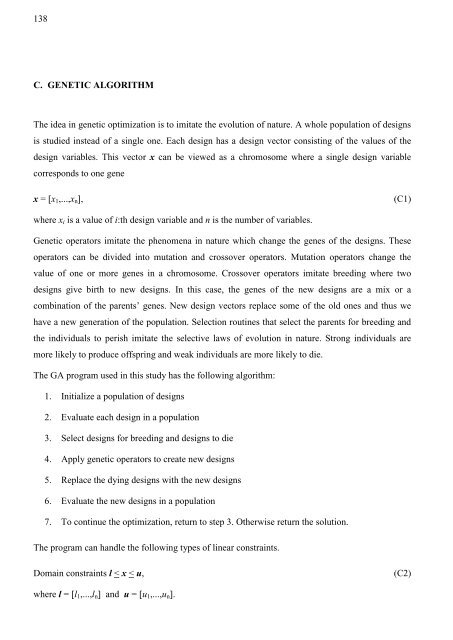Design and Voltage Supply of High-Speed Induction - Aaltodoc
Design and Voltage Supply of High-Speed Induction - Aaltodoc
Design and Voltage Supply of High-Speed Induction - Aaltodoc
Create successful ePaper yourself
Turn your PDF publications into a flip-book with our unique Google optimized e-Paper software.
138<br />
C. GENETIC ALGORITHM<br />
The idea in genetic optimization is to imitate the evolution <strong>of</strong> nature. A whole population <strong>of</strong> designs<br />
is studied instead <strong>of</strong> a single one. Each design has a design vector consisting <strong>of</strong> the values <strong>of</strong> the<br />
design variables. This vector x can be viewed as a chromosome where a single design variable<br />
corresponds to one gene<br />
x = [x1,...,xn], (C1)<br />
where xi is a value <strong>of</strong> i:th design variable <strong>and</strong> n is the number <strong>of</strong> variables.<br />
Genetic operators imitate the phenomena in nature which change the genes <strong>of</strong> the designs. These<br />
operators can be divided into mutation <strong>and</strong> crossover operators. Mutation operators change the<br />
value <strong>of</strong> one or more genes in a chromosome. Crossover operators imitate breeding where two<br />
designs give birth to new designs. In this case, the genes <strong>of</strong> the new designs are a mix or a<br />
combination <strong>of</strong> the parents’ genes. New design vectors replace some <strong>of</strong> the old ones <strong>and</strong> thus we<br />
have a new generation <strong>of</strong> the population. Selection routines that select the parents for breeding <strong>and</strong><br />
the individuals to perish imitate the selective laws <strong>of</strong> evolution in nature. Strong individuals are<br />
more likely to produce <strong>of</strong>fspring <strong>and</strong> weak individuals are more likely to die.<br />
The GA program used in this study has the following algorithm:<br />
1. Initialize a population <strong>of</strong> designs<br />
2. Evaluate each design in a population<br />
3. Select designs for breeding <strong>and</strong> designs to die<br />
4. Apply genetic operators to create new designs<br />
5. Replace the dying designs with the new designs<br />
6. Evaluate the new designs in a population<br />
7. To continue the optimization, return to step 3. Otherwise return the solution.<br />
The program can h<strong>and</strong>le the following types <strong>of</strong> linear constraints.<br />
Domain constraints l < x < u, (C2)<br />
where l = [l1,...,ln] <strong>and</strong> u = [u1,...,un].
















